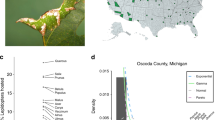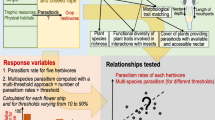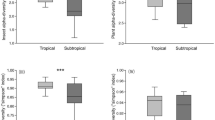Abstract
Global conversion of natural habitats to agriculture has led to marked changes in species diversity and composition1. However, it is less clear how habitat modification affects interactions among species2. Networks of feeding interactions (food webs) describe the underlying structure of ecological communities, and might be crucially linked to their stability and function3,4,5,6,7. Here, we analyse 48 quantitative food webs8,9 for cavity-nesting bees, wasps and their parasitoids across five tropical habitat types. We found marked changes in food-web structure10,11 across the modification gradient, despite little variation in species richness. The evenness of interaction frequencies declined with habitat modification, with most energy flowing along one or a few pathways in intensively managed agricultural habitats. In modified habitats there was a higher ratio of parasitoid to host species and increased parasitism rates, with implications for the important ecosystem services, such as pollination and biological control, that are performed by host bees and wasps12. The most abundant parasitoid species was more specialized in modified habitats, with reduced attack rates on alternative hosts. Conventional community descriptors failed to discriminate adequately among habitats, indicating that perturbation of the structure and function of ecological communities might be overlooked in studies that do not document and quantify species interactions. Altered interaction structure therefore represents an insidious and functionally important hidden effect of habitat modification by humans.
This is a preview of subscription content, access via your institution
Access options
Subscribe to this journal
Receive 51 print issues and online access
$199.00 per year
only $3.90 per issue
Buy this article
- Purchase on Springer Link
- Instant access to full article PDF
Prices may be subject to local taxes which are calculated during checkout


Similar content being viewed by others
References
Tilman, D. et al. Forecasting agriculturally driven global environmental change. Science 292, 281–284 (2001)
van der Putten, W. H. et al. Trophic interactions in a changing world. Basic Appl. Ecol. 5, 487–494 (2004)
McCann, K. The diversity–stability debate. Nature 405, 228–233 (2000)
Melián, C. J. & Bascompte, J. Food web structure and habitat loss. Ecol. Lett. 5, 37–46 (2002)
Ives, A. R. & Cardinale, B. J. Food-web interactions govern the resistance of communities after non-random extinctions. Nature 429, 174–177 (2004)
Rooney, N., McCann, K., Gellner, G. & Moore, J. C. Structural asymmetry and the stability of diverse food webs. Nature 442, 265–269 (2006)
Montoya, J. M., Pimm, S. L. & Solé, R. V. Ecological networks and their fragility. Nature 442, 259–264 (2006)
Memmott, J., Godfray, H. C. J. & Gauld, I. D. The structure of a tropical host–parasitoid community. J. Anim. Ecol. 63, 521–540 (1994)
Müller, C. B., Adriaanse, I. C. T., Belshaw, R. & Godfray, H. C. J. The structure of an aphid–parasitoid community. J. Anim. Ecol. 68, 346–370 (1999)
Bersier, L. F., Banasek-Richter, C. & Cattin, M. F. Quantitative descriptors of food-web matrices. Ecology 83, 2394–2407 (2002)
Banasek-Richter, C., Cattin, M. F. & Bersier, L. F. Sampling effects and the robustness of quantitative and qualitative food-web descriptors. J. Theor. Biol. 226, 23–32 (2004)
Losey, J. E. & Vaughan, M. The economic value of ecological services provided by insects. Bioscience 56, 311–323 (2006)
Foley, J. A. et al. Global consequences of land use. Science 309, 570–574 (2005)
Paine, R. T. Food webs: Road maps of interactions or grist for theoretical development? Ecology 69, 1648–1654 (1988)
Janzen, D. H. The deflowering of Central America. Nat. Hist. 83, 48–53 (1974)
Kearns, C. A., Inouye, D. W. & Waser, N. M. Endangered mutualisms: the conservation of plant–pollinator interactions. Annu. Rev. Ecol. Syst. 29, 83–112 (1998)
Costanza, R. et al. The value of the world’s ecosystem services and natural capital. Nature 387, 253–260 (1997)
Cohen, J. E. et al. Improving food webs. Ecology 74, 252–258 (1993)
Goldwasser, L. & Roughgarden, J. Sampling effects and the estimation of food-web properties. Ecology 78, 41–54 (1997)
Martinez, N. D., Hawkins, B. A., Dawah, H. A. & Feifarek, B. P. Effects of sampling effort on characterization of food-web structure. Ecology 80, 1044–1055 (1999)
Morris, R. J., Lewis, O. T. & Godfray, H. C. J. Experimental evidence for apparent competition in a tropical forest food web. Nature 428, 310–313 (2004)
Lewis, O. T. et al. Structure of a diverse tropical forest insect–parasitoid community. J. Anim. Ecol. 71, 855–873 (2002)
Memmott, J. The structure of a plant–pollinator food web. Ecol. Lett. 2, 276–280 (1999)
Henneman, M. L. & Memmott, J. Infiltration of a Hawaiian community by introduced biological control agents. Science 293, 1314–1316 (2001)
Kremen, C., Williams, N. M. & Thorp, R. W. Crop pollination from native bees at risk from agricultural intensification. Proc. Natl Acad. Sci. USA 99, 16812–16816 (2002)
Tylianakis, J. M., Klein, A. M. & Tscharntke, T. Spatiotemporal variation in the effects of a tropical habitat gradient on Hymenoptera diversity. Ecology 86, 3296–3302 (2005)
Tylianakis, J. M., Klein, A. M. & Tscharntke, T. Spatial scale of observation affects α, β and γ diversity of cavity-nesting bees and wasps across a tropical land use gradient. J. Biogeogr. 33, 1295–1304 (2006)
Rand, T., Tylianakis, J. M. & Tscharntke, T. Spillover edge effects: the dispersal of agriculturally-subsidized insect natural enemies into adjacent natural habitats. Ecol. Lett. 9, 603–614 (2006)
Tylianakis, J. M., Tscharntke, T. & Klein, A. M. Diversity, ecosystem function and stability of parasitoid–host interactions across a tropical habitat gradient. Ecology 87, 3047–3057 (2006)
Hawkins, B. A., Mills, N. J., Jervis, M. A. & Price, P. W. Is the biological control of insects a natural phenomenon? Oikos 86, 493–506 (1999)
Acknowledgements
We thank J. Bascompte, M. B. Bonsall, M. M. Bos, H. C. J. Godfray, B. A. Hawkins, R. J. Morris, C. B. Müller and T. Roslin for discussions or comments, and J. Casquete, J. Pico, G. Sacoto, C. Valarezo, C. Calderon, A. Choez, J. Lino, R. Olschewski, G. H. J. de Koning and B. Pico for assistance with field or laboratory work and coordination. H. C. J. Godfray provided software and advice for drawing food webs and calculating compartmentalization. This research was funded by the Federal Ministry for Research and Education (BMBF) Germany, and a Royal Society University Research Fellowship to O.T.L.
Author Contributions J.M.T. was responsible for writing, field data collection, research planning and analysis; T.T. for research planning, site selection and funding application; and O.T.L. for writing, analysis and preparation of food webs (Fig. 1). All authors discussed the results and edited the manuscript.
Author information
Authors and Affiliations
Corresponding author
Ethics declarations
Competing interests
Reprints and permissions information is available at www.nature.com/reprints. The authors declare no competing financial interests.
Supplementary information
Supplementary Information
This file contains Supplementary Methods 1-3 detailing calculation of food web statistics, and analyses of evenness and parasitism; Supplementary Figure 1 showing qualitative food web values across habitats; and Supplementary Tables 1-4 presenting results of supporting analyses and details of host and parasitoid codes used in Fig. 1. (PDF 563 kb)
Rights and permissions
About this article
Cite this article
Tylianakis, J., Tscharntke, T. & Lewis, O. Habitat modification alters the structure of tropical host–parasitoid food webs. Nature 445, 202–205 (2007). https://doi.org/10.1038/nature05429
Received:
Accepted:
Issue Date:
DOI: https://doi.org/10.1038/nature05429
This article is cited by
-
Biological, ecological and trophic features of invasive mosquitoes and other hematophagous arthropods: What makes them successful?
Biological Invasions (2024)
-
Habitat types in the Atlantic Forest differently influence community structure and species interaction of cavity-nesting Hymenoptera and their natural enemies
Journal of Insect Conservation (2023)
-
Effect of altitude and spatial heterogeneity on the host-parasite relationship in anurans from a remnant humid forest in the brazilian semiarid
Parasitology Research (2023)
-
More than aphids in the guts of coccinellids revealed by molecular and visual analyses
BioControl (2023)
-
Arctic and red fox population responses to climate and cryosphere changes at the Arctic’s edge
Oecologia (2023)
Comments
By submitting a comment you agree to abide by our Terms and Community Guidelines. If you find something abusive or that does not comply with our terms or guidelines please flag it as inappropriate.



